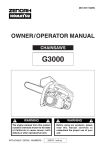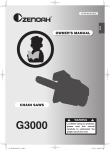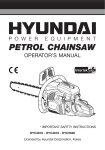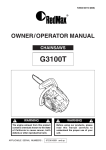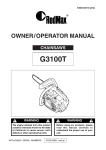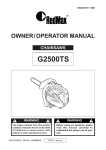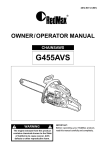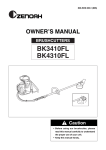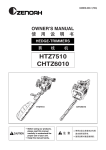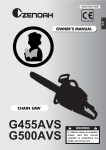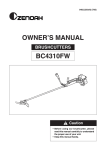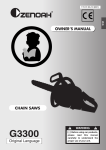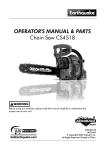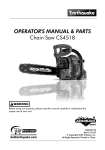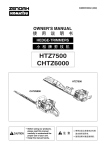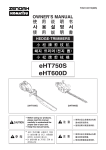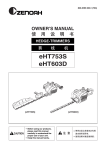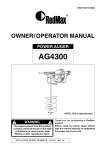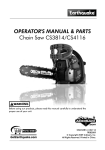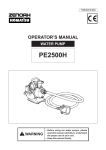Download Zenoah G3000 Specifications
Transcript
2631-93113 (205) OWNER / OPERATOR MANUAL CHAINSAWS G3000 WARNING WARNING The engine exhaust from this product contains chemicals known to the State of California to cause cancer, birth defects or other reproductive harm. Before using our products, please read this manual carefully to understand the proper use of your unit. APPLICABLE SERIAL NUMBERS : 200101 and up SAFETY FIRST Instructions contained in warnings within this manual marked with a symbol concern critical points which must be taken into consideration to prevent possible serious bodily injury, and for this reason you are requested to read all such instructions carefully and follow them without fail. ■ WARNINGS IN THE MANUAL WARNING This mark indicates instructions which must be followed in order to prevent accidents which could lead to serious bodily injury or death. IMPORTANT This mark indicates instructions which must be followed, or it leads to mechanical failure, breakdown, or damage. NOTE This mark indicates hints or directions useful in the use of the product. 1. 2. 3. 4. 5. 6. 7. 8. 9. 10. 11. CONTENTS Parts location …………………………………3 Specifications …………………………………3 Symbols on the machine ……………………4 For safe operation ……………………………5 Installing guide bar and saw chain …………7 Fuel and chain oil ……………………………8 Operation ……………………………………10 Sawing ………………………………………13 Maintenance …………………………………16 Storage ………………………………………19 Disposal ………………………………………19 1. Parts location 1. Guide Bar 2. Saw Chain 3. Front Guard 4. Front Handle 5. Rear Handle 6. Chain Cover 7. Fuel Tank Cap 8. Oil Tank Cap 9. Air Cleaner 2. Specifications ■ G3000 Power unit : Displacement ········································································································· 28.5cm3 Fuel ········································································· Mixture(Gasoline 50 : 2-cycle oil 1) ❈ Fuel tank capacity ···································································································· 0.22 Chain oil ························································································ Motor oil SAE #10W-30 Oil tank capacity ······································································································· 0.13 Carburetor ································································································· Diaphragm type lgnition system ··································································································· Solid-state Spark plug ······························································································· Champion CJ-8Y Oil feeding system ····································································· Mechanical plunger pump Sprocket : Pitch – No. of teeth ·························································· 3/8in(9.38 mm) – 6T Dimensions : LxWxH ·············································································· 260x230x240mm Dry weight ·················································································································· 3.2kg ❈ Oil : ZENOAH genuine oil or JASO FC GRADE OIL or ISO EGC GRADE Cutting attachment : Guide bar : Type – Size ························································ Sprocket nose – 12in (30cm) Saw chain : Type – Pitch – Gauge ················ Oregon 91PX – 3/8(9.375) – 0.050(1.25) in(mm) Specifications are subject to change without notice. 3 3. Symbols on the machine For safe operation and maintenance, symbols are on the machine. According to these indications, please be careful not to take a mistake. (a). The port to refuel the “MIX GASOLINE” Position: fuel tank cap (b). The port to refuel the “CHAIN OIL” Position: oil cap (c). The indication regarding the switch. Flipping the engine switch to the “O” (STOP) direction, the engine stops. Position: upper part of the unit (d). The indication regarding the choke. Pulling out the choke knob, the choke closes. Position: front of the chain cover (e). The position of H-needle The position of L-needle The position of idle adjusting screw Position: Front of the chain cover 4 4. For safe operation 1. Never operate a chain saw when you are fatigued, ill, or upset, or under the influence of medication that may make you drowsy, or if you are under the influence of alcohol or drugs. 2. Use safety footwear, snug fitting clothing and eye, hearing and head protection devices. 3. Always use caution when handling fuel. Wipe up all spills and then move the chain saw at least 3m from the fueling point before starting the engine. 3a) Eliminate all sources of sparks or flame (ie. smoking, open flames, or work that can cause sparks) in the areas where fuel is mixed, poured, or stored. 3b) Do not smoke while handling fuel or while operating the chain saw. 4. Do not allow other persons to be near the chain saw when starting the engine or cutting a wood. Keep bystanders and animals out of the work area. Children, pets, and bystanders should be a minimum of 10m away when you start or operate the chain saw. 5. Never start cutting until you have a clear work area, secure footing, and planned retreat path from the falling tree. 6. Always hold the chain saw firmly with both hands when the engine is running. Use a firm grip with thumb and fingers encircling the chain saw handles. 7. Keep all parts of your body away from the saw chain when the engine is running. 8. Before you start the engine, make sure the saw chain is not contacting anything. 9. Always carry the chain saw with the engine stopped, the guide bar and saw chain to the rear, and the muffler away from your body. 10. Always inspect the chain saw before each use for worn, Ioose, or changed parts. Never operate a chain saw that is damaged, improperly adjusted, or is not completely and securely assembled. Be sure that the saw chain stops moving when the throttle control trigger is released. 11. All chain saw service, other than the items listed in the Operator’s Manual, should be performed by competent chain saw service personnel. (e.g., if improper tools are used to remove the flywheel, or if an improper tool is used to hold the flywheel in order to remove the clutch, structural damage to the flywheel could occur which could subsequently cause the flywheel to disintegrate). 12. Always shut off the engine before setting it down. 13. Use extreme caution when cutting small size brush and saplings because slender material may catch the saw chain and be whipped toward you or pull you off balance. 14. When cutting a limb that is under tension, be alert for spring back so that you will not be struck when the tension in the wood fibers is released. 15. Keep the handles dry, clean and free of oil or fuel mixture. 5 4. For safe operation 16. Operate the chain saw only in well ventilated areas. Never start or run the engine inside a closed room or building. Exhaust fumes contain dangerous carbon monoxide. 19. When transporting your chain saw, make sure the appropriate guide bar scabbard is in place. 17. Do not operate a chain saw in a tree unless specially trained to do so. 18. Guard against kickback. Kickback is the upward motion of the guide bar which occurs when the saw chain at the nose of the guide bar contacts an object. Kickback can lead to dangerous loss of control of the chain saw. KICKBACK SAFETY PRECAUTIONS FOR CHAIN SAW USERS WARNING ● Kickback may occur when the nose or tip of the guide bar touches an object, or when the wood closes in and pinches the saw chain in the cut. Tip contact in some cases may cause a lightning fast reverse reaction, kicking the guide bar up and back towards the operator. Pinching the saw chain along the top of the guide bar may push the guide bar rapidly back towards the operator. Either of these reactions may cause you to lose control of the saw which could result in serious personal injury. ● Do not rely exclusively on the safety devices built into your saw. As a chain saw user you should take several steps to keep cutting jobs free from accident or injury. (1) With a basic understanding of kickback you can reduce or eliminate the element of surprise. Sudden surprise contributes to accidents. (2) Keep a good grip on the saw with both hands, the right hand on the rear handle, and the left hand on the front handle, when the engine is running. Use a firm grip with thumbs and fingers encircling the chain saw handles. A firm grip will help you reduce kickback and maintain control of the saw. Don’t let go. (3) Make certain that the area in which you’re cutting is free from obstructions. Do not let the nose of the guide bar contact a log, branch, or any other obstruction which could be hit while you are operating the saw. (4) Cut at high engine speeds. (5) Do not overreach or cut above shoulder height. (6) Follow manufacturers sharpening and maintenance instructions for saw chain. (7) Only use replacement bars and chains specified by the manufacturer or the equivalent. 6 5. Installing guide bar and saw chain SE1 A standard saw unit package contains the items as shown. (SE1) Open the box and install the guide bar and the saw chain to the power unit as follows. WARNING The saw chain has very sharp edges. Use thick, protective gloves to avoid injury. SE2 SE3 1. Loosen a nut and remove the chain cover. 2. Mount the guide bar and fit the saw chain around the bar and the drive sprocket. Pay attention to the correct direction of the saw chain. (SE1,SE2) 3. Fit the chain tensioner nut into the lower hole of the guide bar, then install the chain cover, and fasten the mounting nut to finger tightness. (SE1) NOTE When installing the chain cover, be sure to fit the hook completely at the rear end of the cover. (SE3) SE4 SE5 4. While holding up the tip of the bar, adjust the chain tension by turning the tensioner screw until the tie straps just touch the bottom side of the bar rail. (SE4) 5. Keep holding the guide bar up, tighten the mounting nut firmly with the attached socket wrench. (SE5) 6. Rotate the saw chain by hand, wearing a protective glove, to see if it turns smoothly without noticeable gap between the tie straps and the guide bar. NOTE A new chain will expand its length in the beginning of use. Check and readjust the tension frequently as a loose chain can easily derail or cause rapid wear of itself and the guide bar. 7 6. Fuel and chain oil WARNING • Gasoline is very flammable. Avoid smoking or bringing any flame or sparks near fuel. Make sure to stop the engine and allow it cool before refueling the unit. Select outdoor bare ground for fueling and move at least 3m (10ft) away from the fueling point before starting the engine. • The ZENOAH engines are lubricated by oil specially formulated for air-cooled 2cycle gasoline engine use. If ZENOAH oil is not available, use an anti-oxidant added quality oil expressly labeled for air-cooled 2-cycle engine use. (JASO FC GRADE OIL or ISO EGC GRADE) • Do not use BIA or TCW (2-stroke watercooling type) mixed oil. ■ RECOMMENDED MIXING RATIO GASOLINE 50:OIL 1 (when using ZENOAH genuine oil) 50:1 MIXING CHART GASOLINE gal. 1 2 3 4 5 2-CYCLE OIL fl.oz 2.6 5.2 7.8 10.4 13 GASOLINE liter 2-CYCLE OIL ml 1 20 2 40 3 60 4 80 5 100 • Exhaust emission are controlled by the fundamental engine parameters and components (eq., carburation, ignition timing and port timing) without addition of any major hardware or the introduction of an inert material during combustion. • These engines are certified to operate on unleaded gasoline. • Make sure to use gasoline with a minimum octane number of 89 RON (USA/Canada: 87AL) • If you use a gasoline of a lower octane value than prescribed, there is a danger that the engine temperature may rise and an engine problem such as piston seizing may consequently occur. • Unleaded gasoline is recommended to reduce the contamination of the air for the sake of your health and the environment. • Poor quality gasolines or oils may damage sealing rings, fuel lines or fuel tank of the engine. ■ HOW TO MIX FUEL IMPORTANT Pay attention to agitation. 1. Measure out the quantities of gasoline and oil to be mixed. 2. Put some of the gasoline into a clean, approved fuel container. 3. Pour in all of the oil and agitate well. 4. Pour In the rest of gasoline and agitate 8 6. Fuel and chain oil again for at least one minute. As some oils may be difficult to agitate depending on oil ingredients, sufficient agitation is necessary for the engine to last long. Be careful that, if the agitation is insufficient, there is an increased danger of early piston seizing due to abnormally lean mixture. 5. Put a clear indication on the outside of the container to avoid mixing up with gasoline or other containers. 6. Indicate the contents on outside of container for easy identification. ■ FUELING THE UNIT 1. Untwist and remove the fuel cap. Rest the cap on a dustless place. 2. Put fuel into the fuel tank to 80% of the full capacity. 3. Fasten the fuel cap securely and wipe up any fuel spillage around the unit. WARNING 5. In the case of storing the product for a long period of time, clean the fuel tank after rendering it empty. Next, activate the engine and empty the carburetor of the composite fuel. 6. In the case of scrapping the used mixed oil container, scrap it only at an authorized repository site. NOTE As lot details of quality assurance, read the description in the section Limited Warranty carefully. Moreover, normal wear and change in product with no functional influence are not covered by the warranty. Also, be careful that, if the usage in the instruction manual is not observed as to the mixed gasoline, etc. described therein, it may not be covered by the warranty. ■ CHAIN OIL Use motor oil SAE 10W-30 all year round, or SAE 30~40 in summer and SAE 20 in winter. 1. Select bare ground for fueling. 2. Move at least 10feet (3meters) away from the fueling point before starting the engine. 3. Stop the engine before refueling the unit. At that time, be sure to sufficiently agitate the mixed gasoline in the container. NOTE FOR YOUR ENGINE LIFE, AVOID; 1. FUEL WITH NO OIL(RAW GASOLINE) – It will cause severe damage to the internal engine parts very quickly. 2. GASOHOL – It can cause deterioration of rubber and/or plastic parts and disruption of engine lubrication. 3. OIL FOR 4-CYCLE ENGINE USE – It can cause spark plug fouling, exhaust port blocking, or piston ring sticking. 4. Mixed fuels which have been left unused for a period of one month or more may clog the carburetor and result in the engine failing to operate properly. Do not use waste or regenerated oil that can cause damage to the oil pump. 9 7. Operation OP1 ■ FUELING THE UNIT (OP1) 1. Remove the fuel tank cap and pour fuel into the tank up to 80% of full capacity. 2. Fasten the fuel cap securely and wipe up any fuel spillage around the unit. 3. Remove the oil tank cap and pour chain oil into the tank. Fasten the cap securely. WARNING 1. Select bare ground for fueling. 2. Move at least 10 feet (3 meters) away from the fueling point before starting the engine. 3. Stop the engine before refueling the unit. WARNING OP2 It is very dangerous to run a chainsaw that mounts broken parts or lacks any parts. Before starting engine, make sure that all the parts including bar and chain are installed properly. ■ STARTING ENGINE WARNING Keep clear of the saw chain as it will start rotating upon starting of the engine. OP3 1. Push the primer pump until fuel flows out in the clear tube. (OP2) 2. Put the ignition switch to “ I ” position. (OP3) OP4 10 3. While holding the throttle lever together with the throttle interlock, push in the side button and release the throttle lever to hold it at the start position. (OP4) 7. Operation OP5 4. Pull out the choke knob to the closed position. (OP5) NOTE When restarting immediately after stopping the engine, Ieave the choke knob at the open position. 5. While holding the saw unit securely on the ground, pull the starter rope vigorously. (OP6) OP6 WARNING Do not start the engine while hanging the chain saw with a hand. The saw chain may touch your body. It's very dangerous. 6. When engine has ignited first, push in the choke knob and pull the rope again to start the engine. 7. Allow the engine to warm up with the throttle lever pulled slightly. ■ CHECKING OIL SUPPLY WARNING OP7 Make sure to set up the bar and the chain when checking the oil supply. If not, the rotating parts may be exposed. It is very dangerous. After starting the engine, run the chain at medium speed and see if chain oil is scattered off as shown in the figure. (OP7) NOTE The oil tank should become nearly empty by the time fuel in the tank is used up. Be sure to refill the oil tank every time when refueling the saw. OP8 ■ STOPPING ENGINE 1. Release the throttle lever and let the engine run at low speed for a moment. 2. Put the ignition switch to the “O” position. (OP8) NOTE In case of emergency, turn off the switch without idling the engine. 11 7. Operation ■ ADJUSTING CARBURETOR (OP9) The carburetor has been adjusted at the factory. Should your unit need readjustment due to the changes in altitude or operating conditions, please let your skillful dealer make the adjustment. A wrong adjustment may cause damage to your unit. If you have to make the adjustment yourself, please carefully follow the procedure below. NOTE Be sure to adjust the carburetor with the bar chain attached. OP9 1. Stop engine and screw in both H and L needles until they stop. Never farce. Then set them back the standard number of turns as shown below. H needle: 11⁄4±1⁄4 L needle: 11⁄4±1⁄4 2. Start engine and allow it a few minutes warming up in low speed. 3. Turn L needle slowly clockwise to find the position where idling speed is maximum, set the needle back a quarter (1/4) turn counterclockwise. L needle should be set in 1/4 turn either wise from the standard position. 4. Turn idle adjusting screw (T) counterclockwise so that saw chain does not turn. If idling speed is too slow, turn the screw clockwise. 5. Make a test cut and adjust the H needle for best cutting power, not for maximum speed. 12 8. Sawing NOTE • Before proceeding to your job, read “For Safe Operation” section. It is recommended to first practice sawing easy logs. This also helps you get accustomed to your unit. • It is not necessary to force the saw into the cut. Apply only light pressure while running the engine at full throttle. • Racing the engine with the chain seized in a cutaway can damage the clutch system. When the saw chain is caught in the cut, do not attempt to pull it out by force, but use a wedge or a lever to open the cut. SA1 ■ • • • TO AVOID KICKBACK (SA1) Hold the chain saw firmly with both hands. Do not overrach. Do not let the nose of the guide bar contact a log, branch, ground or any other obstruction. • Cut at high engine speeds. • Don’t cut above shoulder height. • Follow manufacturer’s sharpening and maintenance instructions for the saw chain. ■ FELLING A TREE (SA2) SA2 WARNING When you fell a tree, be sure to warn your neighboring workers of the danger. 1. Decide the felling direction considering the wind, Iean of the tree, location of heavy branches, ease of job after felling, and other factors . 2. While clearing the area around the tree, arrange a good foothold and retreat path. 3. Make a notch cut one-third of the way into the tree on the felling side. 4. Make a felling cut from the opposite side of the notch and at a level slightly higher than the bottom of the notch. 13 8. Sawing ■ LOGGING AND LIMBING WARNING 1. Always ensure your foothold as well as stability of the tree. 2. Be alert to the rolling over of a cut log. 3. Read the instructions in “For safe operation” to avoid kickback of the saw. SA3 Before starting work, check the direction of bending force inside the log to be cut. Always finish cutting from the opposite side of bending direction to prevent the guide bar from being caught in the cutaway. ● Cutting an unpillowed log Saw down halfway, then roll the log over and cut from the opposite side. (SA3) SA4 ● Cutting a pillowed log In the area A in the picture right above, saw up from the bottom one-third and finish by sawing down from the top. In the area B, saw down from the top one-third and finish by sawing up from the bottom. (SA4) ● Limbing a felled tree SA5 WARNING Be alert to the spring back of a cut limb. First check which way the limb is bent. Then make a shallow cut into the compressed side to prevent the limb from being torn. Cut through from the tensed side. (SA5) 14 8. Sawing ● Pruning SA6 WARNING 1. Do not use an unstable foothold or a stepladder. 2. Do not overreach. 3. Do not cut above shoulder height. 4. Always use both hands to grip the saw. Cut up from the bottom, finish down from the top. (SA6) 15 9. Maintenance MA1 WARNING Make sure to stop the engine before inspecting and/or servicing the unit. ■ DAILY MAINTENANCE MA2 SAW CHAIN It is one of the essential factors for smooth and safe operation to keep the cutters always in good condition. It’s time to reform the cutters when; 1. Sawdust has become powder-like. 2. You need extra force to saw in. 3. The cutaway tends to curve by itself. 4. The unit vibrates abnormally when sawing. 5. Fuel consumption has increased. MA3 MA4 16 REFORMING CUTTER 1. Wear work gloves. 2. Use 5/32 inch (4mm) round file. 3. Hold the guide bar and the saw chain firmly. 4. Place the file on the cutter and push straight forward while keeping the file angles and the height as shown in the picture. 5. Make sure that every cutter has the same length and the edge angles as shown in the picture. 6. After every cutter has been set, check the depth gauge and file it to the proper level as necessary. Do not file off beyond the specified level, or the cutting edge can be damaged very quickly. 9. Maintenance MA5 GUIDE BAR 1. Remove sawdust in the bar groove and the oiling port. (MA5) 2. Grease the nose sprocket from the feeding port on the tip of the guide bar. (MA6) MA6 MA7 MA8 3. Periodically turn over the guide bar when mounting it to the unit, in order to prevent partial wear. 4. The bar rail should always be a square. Check for wear of the bar rail. Apply a ruler to the bar and the outside of a cutter. If a gap is observed between them, the rail is normal. Otherwise, the bar rail is worn. Such a bar needs to be corrected or replaced. (MA7) AIR FILTER A clogged air filter can reduce the engine performance. Daily check the filter elements and tap off attached saw dust. When cleaning, use warm, soapy water and dry completely before installing. When the element is broken or shrunk, replace with a new one. (MA8) 17 9. Maintenance MA9 OILING PORT Dismount the guide bar and check the oiling port for blocking by sawdust. (MA9) GENERAL Inspect the entire unit for fuel leakage, Ioose fastenings, and damage to major parts, especially handle joints and guide bar mounting. When anything wrong be found, make sure to have it repaired before next usage. MA10 ■ MONTHLY MAINTENANCE FUEL FILTER When the engine runs short of fuel supply, check the fuel filter for blockage. (MA10) MA11 OIL STRAINER Drain the oil tank and remove the oil strainer located near the spark plug. Check the condition and clean if necessary. (MA11) MA12 SPARK PLUG Starting failure and mis-firing are often caused by a fouled spark plug. Periodically clean the spark plug and check that the spark gap is in the correct range. (MA12) For a replacement plug, use Champion CJ-8Y or RCJ-8Y, or NGK BPM7A. .025 in 0.6 mm MA13 18 DRIVE SPROCKET Periodically check the drive sprocket for wear and damage, and replace when the teeth have worn over 1mm, or when any damage has been observed. (MA13) 9. Maintenance HANDLE MOUNTING JOINTS Inspect the handle mounting joints and replace when any adhered part is peeled off or a crack is observed on the rubber part. Also replace when the inside of the rear damper metal has worn remarkably. 10. Storage 1. Empty the fuel tank and run the engine out of fuel. 2. Empty the oil tank. 3. Clean the entire unit. 4. Store the unit in a dry place out of the reach of children. 11. Disposal When disposing your machine, fuel or oil for the machine, be sure to allow your local regulations. 19 Head Office: 1-9, Minamidai, Kawagoe-city, Saitama, 350-1165 Japan Telephone: (+81)49-243-1117 Telecopier: (+81)49-243-7197 PRINTED IN JAPAN




















